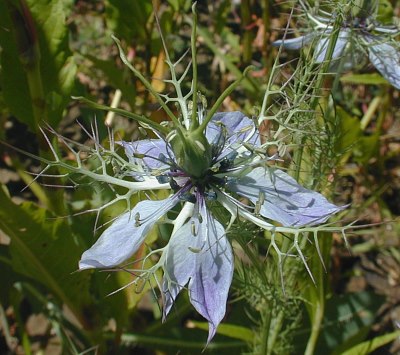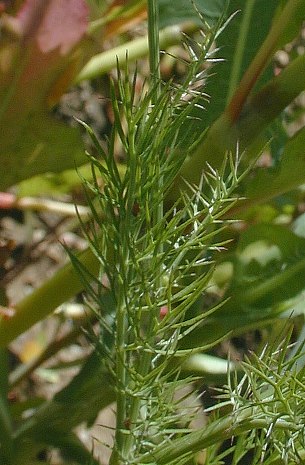Description: This plant is a winter annual about ½–2' tall that is erect and branches occasionally. The hairless stems are medium green, terete, and often slightly grooved. The alternate leaves are up to 3" long and 1½" across; they are irregularly bipinnatifid and ascending. The lobes of mature leaves are medium green, hairless, and filiform (worm-like and circular in cross-section); however, the lobes of young leaves during the spring are often linear (flattened in cross-section). The upper stems terminate in individual flowers spanning about ¾–1½" across.

Each
flower has 5 petal-like sepals, 5 insignificant petals, 5 carpels that
are joined together, and numerous stamens. The petal-like sepals are
usually pale metallic blue, although other colors are possible; they
are elliptic in shape and widely spreading. Immature carpels are green
and hairless; each carpel has a beak-like style that is also green and
resembles one of the lobes of the leaves. Underneath each flower, there
is a whorl of about 5 bipinnatifid bracts that are very similar to the
leaves in appearance; their lobes are hairless, green, and filiform.
The blooming
period usually occurs from late spring to mid-summer and lasts about
1-2 months for a colony of plants. However, some plants may bloom later
if they germinated during the spring, rather than the fall. Each flower
is replaced by a large ovoid fruit consisting of 5 beaked follicles
(seed capsules) that are joined together in the center. These follicles
turn brown at maturity and split open to release their seeds; there are
numerous seeds per follicle. The small seeds are somewhat flattened and
black. The root system is fibrous. This plant reproduces are reseeding
itself.
 Cultivation:
Love-in-a-Mist is very adaptable in cultivation, although it prefers
full sunlight. In its native habitat, it is usually found in moist
sandy soil, but it also tolerates drier conditions and many kinds of
soil, including those containing loam, clay-loam, and gravelly or rocky
material. It is usually better to plant the seeds during the fall than
the spring; the young seedlings are winter-hardy.
Cultivation:
Love-in-a-Mist is very adaptable in cultivation, although it prefers
full sunlight. In its native habitat, it is usually found in moist
sandy soil, but it also tolerates drier conditions and many kinds of
soil, including those containing loam, clay-loam, and gravelly or rocky
material. It is usually better to plant the seeds during the fall than
the spring; the young seedlings are winter-hardy.
Range & Habitat:
In Illinois, Love-in-a-Mist occasionally escapes from cultivation, but
it rarely persists from year-to-year. So far, collections of this plant
have been made in 2 counties (see Distribution
Map). In addition, the webmaster has photographed some
escaped plants in Champaign County. Habitats include meadows, fallow
fields, and waste areas. Love-in-a-Mist is often cultivated in gardens,
where it often reseeds itself. Usually, escaped plants are
single-flowered forms, rather than double-flowered forms with greater
than 5 sepals. This species is native to southern Europe, north Africa,
and western areas of the Middle East.
Faunal Associations:
Very little is known about floral-faunal relationships for this species
in North America. Sometimes bees visit the flowers for their pollen.
Photographic Location:
A fallow field near Champaign, Illinois; the photographed plant is a
single-flowered form.
Comments:
To me, this flowering plant looks like something from outer space – it
has an unearthly and slightly menacing appearance! Love-in-a-Mist is a
member of a small genus of plants in the Buttercup family that are
found primarily in the Mediterranean area of the Old World. The only
other species in this genus that has received much attention, Nigella
sativa (Black Cumin), is a culinary herb with edible black
seeds. They are supposed to have a peppery-oregano flavor. Sometimes
the seeds of Love-in-a-Mist have been used to flavor food as well.
These two species are fairly easy to distinguish – the mature leaves of
Love-in-a-Mist have filiform lobes (worm-like & circular in
cross-section), while the mature leaves of Black Cumin have linear
lobes (flattened in cross-section). Another common name of Nigella
damascena is Devil-in-the-Bush.